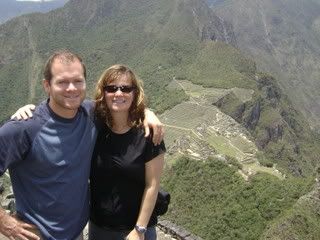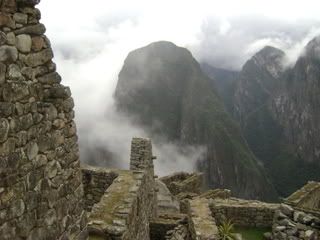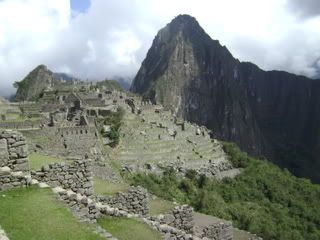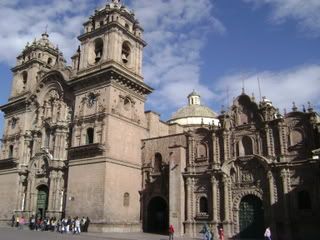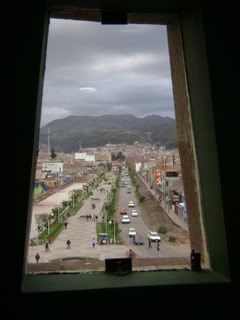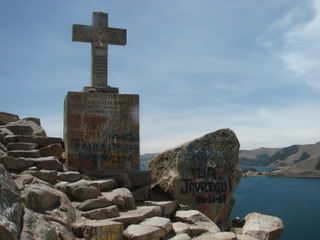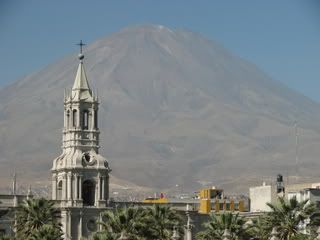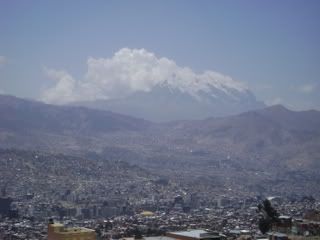We had tried to get Bill to come with us by bus -- it´s a third of the price of flying -- but he took one look at the 19-hour travel time and said no way.
Our bus left at 2 p.m. and was scheduled to arrive in Lima about 9 the next morning. We were traveling with a company called Cruz del Sur. Normally we give hardly any thought at all to what bus company we travel with but of the number of things complicating life for travelers in Peru is bus travel and personal safety. One issue, which we can do nothing about, is hijackings, which have occured but which we have heard little about recently. The other problem is theft on busses. Cheap busses tend to stop constantly, and since many longhaul busses here travel at night it´s much easier to get stuff stolen on a bus which is stopping all the time since there are that many more people getting on and off. The better bus companies pick passengers up at one end and hardly stop at all until they get to the other. Cheaper bus companies are also more likely to have drunk drivers, bad drivers and no onboard attendant -- not that I need to be served, but the presence of an attendant can help deter theft between passengers.
The bus climbed out of Cuzco and began to traipse across the staggering Peruvian topography. It´s 18,000 foot glacier clad mountains, ridiculously steep mountains, and bottomless valleys. The road constantly climbed to 11,000 or 12,000 feet to cross a pass then descended just as quickly to 6,000 feet to cross a river. I woke up at one point in the night finding it hard to breathe. I looked at my altimeter and found we were over 14,500 feet. I let my watch accumulate vertical feet of descent for the trip and by the time we got to Lima it had tallied up 48,000 total vertical feet.
(Trail to Laguna Churup)

Day dawned with us back on the coastal desert -- sand, fog and eerieness. We pulled into Lima late, at about 10:30. Annoyingly, there is no central bus station in Lima. Instead, each company has an office. Ours was along a freeway. Bus stations are grimy, but convenient since you can go from company to company and see who is going where when. Instead, we bought a ticket for the next day to Huaraz and wound up with an unexpected day in one of the world´s largest cities.
It was not a day we wanted to have. We´re running short of time and still have a few countries to go before we fly out of Quito on Nov. 15. Besides, Lima at first glance was not what you´d call fun.
We took a taxi to the nicest part of town and checked into what our Lonely Planet guidebook recommended as a ´splurge.´The Hostal del Patio was in the city´s best neighborhood and close to the coast, but like so many other things about Lonely Planet I take exception to its recommendation. Lonely Planet´s idea of a great hotel is one with large rooms, attentive personalized service and, inevitably, flower draped patios and courtyards. This had all that and, for $48 a night, no hot water and moldy mattresses. We ate at a posh sidewalk cafe, walked through a fancy outdoor mall set on a cliff over the ocean, and watched hang gliders take off from a bluff over the Pacific.
(Nevada Churup, outside of Huaraz, about 17,000 feet high)
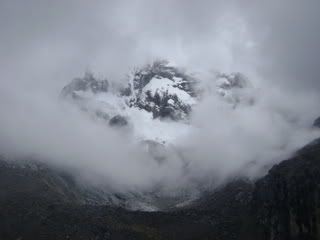
We were back at the bus station the next morning. The Cruz del Sur for Huaraz left on time and spent an hour plodding through the endless sprawl of Lima. What looked like a regular old ugly city on the south side morphed into a seriously wretched city on the north side. Laura remarked at one point it did not look all that different from Calcutta, and I had to agree.
Away from town we were back into the vertical world of Peru. We rolled into Huaraz at 5 p.m. after cresting yet another bleak 14,000 foot pass.
Huaraz is the principal city of Peru´s northern Andean region. It was flattened by an earthquake in 1970 and is still in many areas being rebuilt, or so it seems. It´s a drab, ugly city of about 100,000, convenient only for its espresso bars and location next to the fantastic Cordillera Blanca, a line of 19,000 foot mountains, and proximity to several other breathtaking ranges.
Unfortunatly for anything having to do with the mountains and outdoor sports, we got here about a month late. As we have traveled north we have gotten into progressively wetter weather, and here, at 10 degrees south latitude, we are squarely in the wet season. It´s clear but for a brief moment in the morning and then gets cloudy as the morning progresses. There is always rain by 1 p.m. and after that the day is pretty much finished.
We did manage to take one hike in the mountains. We hired a guide, who packed us a lunch and hired our group a taxi, and hiked to Laguna Churup. Yet another of the things complicating life for travlers in Peru is the likelihood of being attacked while hiking. It´s hard to pin down exactly when and where it is the most dangerous, but the bottom line is you can´t go traipsing around in the backcountry on your lonesome. At least Jesus was a nice guide.
We left town at 7:30 as clouds were beginning to build. We drove from town, at 10,000 feet, to the trailhead at 12,200 feet. From there we followed a trail into a narrow canyon and hiked up alongside a waterfall. From there the trail was inches wide, wet, and we were pelted with spray from the waterfall and water falling from the cliffs above. Much of the way was legitimate rock climbing, and Laura took a bad fall and scraped her knees and poked gaping holes in her pants -- the North Face pants that have now been to five continents on her. Laguna Churup was a wash of blue and green at 14,000 feet and ended at a headwall which led up to Nevada Churup, some 17,000 feet tall. We were back in town by 3 p.m. for chocolate cake and the regular afternoon downpour.
New snow on the mountains this morning. We did not feel like doing much but do have a night bus at 9 p.m. for Trujillo. We´re making a B-line for Ecuador. Hope to make it by Saturday.
